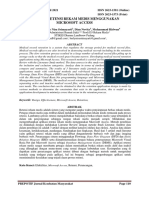0% found this document useful (0 votes)
36 views4 pagesJava Exam Preparation Notes Part1
The document provides comprehensive Java exam preparation notes covering key concepts such as object-oriented programming features, access specifiers, the main method declaration, the final keyword, garbage collection, and the differences between abstract classes and interfaces. It also explains the roles of JVM, JRE, and JDK, along with exception handling and the functionality of arrays in Java. Each topic is detailed with definitions, examples, and explanations to aid in understanding Java programming.
Uploaded by
nancyokay001Copyright
© © All Rights Reserved
We take content rights seriously. If you suspect this is your content, claim it here.
Available Formats
Download as DOCX, PDF, TXT or read online on Scribd
0% found this document useful (0 votes)
36 views4 pagesJava Exam Preparation Notes Part1
The document provides comprehensive Java exam preparation notes covering key concepts such as object-oriented programming features, access specifiers, the main method declaration, the final keyword, garbage collection, and the differences between abstract classes and interfaces. It also explains the roles of JVM, JRE, and JDK, along with exception handling and the functionality of arrays in Java. Each topic is detailed with definitions, examples, and explanations to aid in understanding Java programming.
Uploaded by
nancyokay001Copyright
© © All Rights Reserved
We take content rights seriously. If you suspect this is your content, claim it here.
Available Formats
Download as DOCX, PDF, TXT or read online on Scribd
/ 4























































































